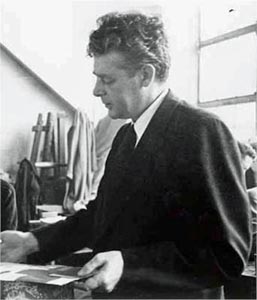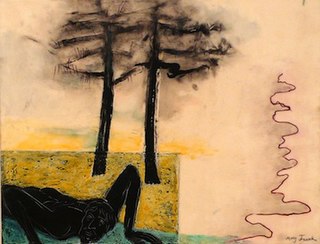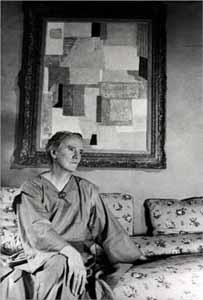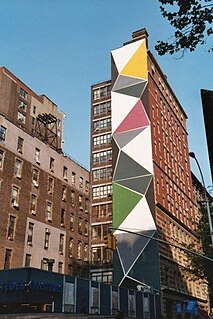
Lenore Tawney was an American artist known for her drawings, personal collages, and sculptural assemblages, who became an influential figure in the development of fiber art.

Burgoyne A. Diller was an American abstract painter. Many of his best-known works are characterized by orthogonal geometric forms that reflect his strong interest in the De Stijl movement and the work of Piet Mondrian in particular. Overall, his Geometric abstraction and non-objective style also owe much to his study with Hans Hofmann at the Art Students League of New York. He was a founding member of the American Abstract Artists. Diller's abstract work has sometimes been termed "constructivist". He also did figurative and representational works early in his career working as a muralist for the New York City Federal Arts Project.

Roger Brown was an American artist and painter. Often associated with the Chicago Imagist groups, he was internationally known for his distinctive painting style and shrewd social commentaries on politics, religion, and art.

Mary Frank is an English visual artist who works as a sculptor, painter, printmaker, draftswoman, and illustrator.

Anne Ryan (1889–1954) was an American Abstract Expressionist artist associated with the New York School. Her first contact with the New York City avant-garde came in 1941 when she joined the Atelier 17, a famous printmaking workshop that the British artist Stanley William Hayter had established in Paris in the 1930s and then brought to New York when France fell to the Nazis. The great turning point in Ryan's development occurred after the war, in 1948. She was 57 years old when she saw the collages of Kurt Schwitters at the Rose Fried Gallery, in New York City, in 1948. She right away dedicated herself to this newly discovered medium. Since Anne Ryan was a poet, according to Deborah Solomon, in Kurt Schwitters’s collages “she recognized the visual equivalent of her sonnets – discrete images packed together in an extremely compressed space.” When six years later Ryan died, her work in this medium numbered over 400 pieces.
Gladys M. Nilsson is an American artist, one of the original Hairy Who Chicago Imagists, a group in the 1960s and 1970s who turned to representational art. Her paintings "set forth a surreal mixture of fantasy and domesticity in a continuous parade of chaotic images." She is married to fellow-artist and Hairy Who member Jim Nutt.
Russ Warren is a contemporary figurative painter who has exhibited extensively throughout the U.S. and abroad, notably in the 1981 Whitney Biennial and the 1984 Venice Biennale. A painter in the Neo-Expressionist style, he has drawn inspiration from Spanish masters such as Velázquez, Goya and Picasso, as well as from Mexican folk art and the American southwest. Committed to his own Regionalist style during his formative years in Texas and New Mexico, he was picked up by Phyllis Kind in 1981. During those years he transitioned to a style characterized by "magical realism", and his work came to rely on symbol allegory, and unusual shifts in scale. Throughout his career, his paintings and prints have featured flat figures, jagged shadows, and semi-autobiographical content. His oil paintings layer paint, often incorporate collage, and usually contain either figures or horses juxtaposed in strange tableaux.

Howardena Pindell is an American artist, curator, and educator. She is known as a painter and mixed media artist, her work explores texture, color, structures, and the process of making art; it is often political, addressing the intersecting issues of racism, feminism, violence, slavery, and exploitation. She is known for the wide variety of techniques and materials used in her artwork; she has created abstract paintings, collages, "video drawings," and "process art."

Tania was a Polish-born, New York based, Jewish American abstract painter, sculptor, collage artist and painter of city walls. She was known by several different married names over the course of her career, but decided as of 1958 to use simply her first name, Tania. She was active in the New York art world from 1949 to 1982, but is perhaps best known for her 13-story geometric wall painting of 1970, which still stands at the corner of Mercer St. & 3rd St. in Greenwich Village, New York. In 1966, she became a founding member of City Walls, Inc., a non-profit organization that commissioned abstract artists to paint walls around New York City, and which would later become the Public Art Fund.

Nicole Eisenman is French-born American artist known for her oil paintings and sculptures. She has been awarded the Guggenheim Fellowship (1996), the Carnegie Prize (2013), and has thrice been included in the Whitney Biennial. On September 29, 2015, she won a MacArthur Fellowship award for "restoring the representation of the human form a cultural significance that had waned during the ascendancy of abstraction in the 20th century."
Christina Ramberg was an American painter associated with the Chicago Imagists, a group of representational artists who attended the School of the Art Institute of Chicago in the late 1960s. The Imagists took their cues from Surrealism, Pop, and West Coast underground comic illustration, and were "enchanted with the abject status of sex in post-war America, particularly as writ on the female form." Ramberg is best known for her depictions of partial female bodies forced into submission by undergarments and imagined in odd, erotic predicaments.

Molly Zuckerman-Hartung is an American painter from Olympia, Washington. Since 2015 she has been faculty in Painting and Printmaking at the Yale School of Art.
Lucy Fradkin is an American self-taught artist from New York who paints portraits which often include collage elements. She is inspired by Persian and Indian miniature paintings with bright palettes and flattened space as well as the ancient frescoes and mosaics of Etruria, Rome, and Byzantium. In addition, she visited the Brooklyn Museum as a young artist with her mother and was inspired by The Dinner Party by Judy Chicago, as a prominent piece of art by a living woman artist.
Pam Lins is an artist based in Brooklyn, NY. She refers to all of her work primarily as sculpture, although she uses the term expansively. Through it she contemplates the social, the political, and the historical by constructing situations inquisitive and equivocal to sculpture and the making of it. Her range of adoptive methods includes painting, producing jewelry, drawing cartoons, and growing mushrooms. She currently teaches at Cooper Union School of Art and Princeton University.
Hannah Black is a visual artist, critic, and writer. Her work spans video, text and performance. She is best known for her open letter written with Ciarán Finlayson and Tobi Haslett, The Tear Gas Biennial, criticizing co-chair of the board of the Whitney Museum, Warren Kanders, and his toxic philanthropy which comes from selling tear gas and other weapons via Safariland. The letter prompted artists to withdraw works from the 2019 Whitney Biennial.
Sue Williams is an American artist born in 1954. She came to prominence in the early 1980s, with works that echoed and argued with the dominant postmodern feminist aesthetic of the time. In the years since, her focus has never waned yet her aesthetic interests have moved toward abstraction along with her subject matter and memories. She lives and works in New York.
Sienna Shields is an American abstract artist specializing in large-format collage pieces. She was also the chief organizer of the HowDoYouSayYaminAfrican? artist collective and the director of its digital work, Good Stock on the Dimension Floor: An Opera which was accepted for the 2014 Whitney Biennial.
Troy Montes-Michie is an American collage artist, painter, interdisciplinary installation artist, and sculptor based in New York City. Michie's work is often in dialogue with the canon of collage; as well as, investigating society's understanding of race, gender, sexuality, and other fields of identity and power.
Adrienne Edwards is a New York-based curator, scholar, and writer. Edwards is currently the Engell Speyer Family Curator and Curator of Performance at the Whitney Museum of American Art.
Bradley Eros is an experimental film director, actor, curator, poet, and performance artist who also makes Musique concrète sound collages, music videos, photographs, live projection performances, works on paper and art objects.









